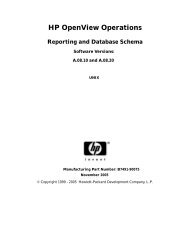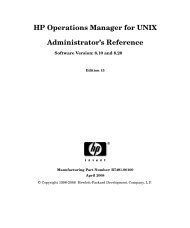- Page 1 and 2: HP OpenView Operations for UNIX Fir
- Page 3: Trademark Notices. Adobe® is a tra
- Page 6 and 7: Contents 3. Configuring HTTPS Nodes
- Page 8 and 9: Contents 8 Example of a port config
- Page 10 and 11: Contents 10 CLIENT_BIND_ADDR() . .
- Page 13 and 14: Conventions The following typograph
- Page 15 and 16: OVO Documentation Map HP OpenView O
- Page 17 and 18: Table 3 OVO Manuals (Continued) Man
- Page 19: OVO Online Information The followin
- Page 22 and 23: 22 ❏ Help Instructions Instructio
- Page 24 and 25: 24 Accessing the Online Help To acc
- Page 26 and 27: Firewall Configuration in OVO About
- Page 28 and 29: Firewall Configuration in OVO OVO C
- Page 30 and 31: Firewall Configuration in OVO OVO C
- Page 32 and 33: Firewall Configuration in OVO OVO C
- Page 36 and 37: Firewall Configuration in OVO Speci
- Page 38 and 39: Firewall Configuration in OVO Speci
- Page 40 and 41: Firewall Configuration in OVO Speci
- Page 42 and 43: Firewall Configuration in OVO Speci
- Page 44 and 45: Firewall Configuration in OVO Netwo
- Page 46 and 47: Firewall Configuration in OVO Netwo
- Page 48 and 49: Advanced Configuration Special Conf
- Page 50 and 51: Advanced Configuration Special Conf
- Page 52 and 53: Configuring HTTPS Nodes 52 This cha
- Page 54 and 55: Configuring HTTPS Nodes Management
- Page 56 and 57: Configuring HTTPS Nodes Configuring
- Page 58 and 59: Configuring HTTPS Nodes Configuring
- Page 60 and 61: Configuring HTTPS Nodes Configuring
- Page 62 and 63: Configuring HTTPS Nodes HTTPS Agent
- Page 64 and 65: Configuring HTTPS Nodes HTTPS Agent
- Page 66 and 67: Configuring HTTPS Nodes HTTPS Agent
- Page 68 and 69: Configuring DCE Nodes 68 This chapt
- Page 70 and 71: Configuring DCE Nodes Management Se
- Page 72 and 73: Configuring DCE Nodes Configuring a
- Page 74 and 75: Configuring DCE Nodes Configuring t
- Page 76 and 77: Configuring DCE Nodes Configuring O
- Page 78 and 79: Configuring DCE Nodes Checking Comm
- Page 80 and 81: Configuring DCE Nodes Windows Manag
- Page 82 and 83: Configuring DCE Nodes Communication
- Page 84 and 85:
Configuring DCE Nodes Communication
- Page 86 and 87:
Configuring DCE Nodes MC/ServiceGua
- Page 88 and 89:
Configuring DCE Nodes Embedded Perf
- Page 90 and 91:
Configuring DCE Nodes Embedded Perf
- Page 92 and 93:
Configuring DCE Nodes Embedded Perf
- Page 94 and 95:
Configuring DCE Nodes Embedded Perf
- Page 96 and 97:
Configuring DCE Nodes Embedded Perf
- Page 98 and 99:
Configuring DCE Nodes Checkpoint Fi
- Page 100 and 101:
Configuring DCE Nodes Checkpoint Fi
- Page 102 and 103:
Configuring DCE Nodes DCE Agents an
- Page 104 and 105:
Configuring DCE Nodes DCE Agents an
- Page 106 and 107:
Configuring DCE Nodes DCE Agents an
- Page 108 and 109:
Configuring DCE Nodes DCE Agents an
- Page 110 and 111:
DCE RPC Communication without Using
- Page 112 and 113:
DCE RPC Communication without Using
- Page 114 and 115:
DCE RPC Communication without Using
- Page 116 and 117:
DCE RPC Communication without Using
- Page 118 and 119:
DCE RPC Communication without Using
- Page 120 and 121:
DCE RPC Communication without Using
- Page 122 and 123:
DCE RPC Communication without Using
- Page 124 and 125:
DCE RPC Communication without Using
- Page 126 and 127:
DCE RPC Communication without Using
- Page 128 and 129:
DCE RPC Communication without Using
- Page 130 and 131:
DCE RPC Communication without Using
- Page 132 and 133:
DCE RPC Communication without Using
- Page 134 and 135:
DCE RPC Communication without Using
- Page 136 and 137:
DCE RPC Communication without Using
- Page 138 and 139:
DCE RPC Communication without Using
- Page 140 and 141:
DCE RPC Communication without Using
- Page 142 and 143:
DCE RPC Communication without Using
- Page 144 and 145:
DCE RPC Communication without Using
- Page 146 and 147:
DCE RPC Communication without Using
- Page 148 and 149:
DCE RPC Communication without Using
- Page 150 and 151:
DCE RPC Communication without Using
- Page 152 and 153:
Generic OVO Variables and Troublesh
- Page 154 and 155:
Generic OVO Variables and Troublesh
- Page 156 and 157:
Generic OVO Variables and Troublesh
- Page 158 and 159:
Generic OVO Variables and Troublesh
- Page 160 and 161:
Generic OVO Variables and Troublesh
- Page 162 and 163:
Generic OVO Variables and Troublesh
- Page 164 and 165:
Generic OVO Variables and Troublesh
- Page 166 and 167:
Generic OVO Variables and Troublesh
- Page 168 and 169:
Generic OVO Variables and Troublesh
- Page 170 and 171:
OVO Variables and Troubleshooting f
- Page 172 and 173:
OVO Variables and Troubleshooting f
- Page 174 and 175:
OVO Variables and Troubleshooting f
- Page 176 and 177:
OVO Variables and Troubleshooting f
- Page 178 and 179:
OVO Variables and Troubleshooting f
- Page 180 and 181:
OVO Variables and Troubleshooting a
- Page 182 and 183:
OVO Variables and Troubleshooting a
- Page 184 and 185:
OVO Variables and Troubleshooting a
- Page 186 and 187:
OVO Variables and Troubleshooting a
- Page 188 and 189:
OVO Variables and Troubleshooting a
- Page 190 and 191:
OVO Variables and Troubleshooting a
- Page 192 and 193:
OVO Variables and Troubleshooting a
- Page 194 and 195:
OVO Variables and Troubleshooting a
- Page 196 and 197:
OVO Variables and Troubleshooting a
- Page 198 and 199:
OVO Variables and Troubleshooting a
- Page 200 and 201:
OVO Variables and Troubleshooting a
- Page 202 and 203:
Index Communication Manager communi
- Page 204 and 205:
Index communication port settings,
- Page 206 and 207:
Index description, 34 NCS NODE desc
- Page 208 and 209:
Index communication port settings,







